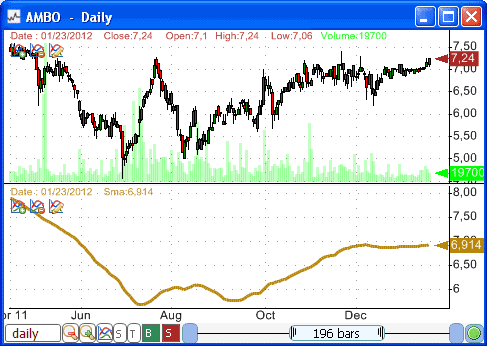The main similarity between technical analysis indicators is that they all use security prices (open, high, low, close and volume) in their calculation. This small number of variables has produced hundreds and even thousands of trading indicators. Technical indicators fall mainly into two categories: Leading and lagging indicators. Leading indicators are those who lead the price movement. They give a signal before a new trend or reversal occurs. Lagging indicators are those who follow the price action. They give a signal after the trend or reversal has started. Indicators from both categories belong to one of the following types: Trend, momentum, volatility or volume indicators. Trend Indicators These indicators are designed to show traders and investors the trend or direction of the asset they are trading. The trend of an asset can be either downwards (we are talking here about bearish trend), upwards (bullish trend) or sideways (no clear direction). Trend followers are an example of traders who use trend indicators to analyze the market. Moving averages, MACD, average directional index, parabolic SAR, linear regression, forecast oscillator are some example of trend indicators. Example: buy = close > sma(30); // Buy when price is higher than 30-bar simple moving average Nb: In order to create a trading system, select "Analysis -> Simulator" then click on "New". You can add trading rules using the wizard or you can type directly your formula (as the example above) by selecting the "Create a trading system using the formula editor" tab.  Momentum Indicators The momentum is a measure of the speed at which the value of a security is moving in a given period. Momentum traders focus on stocks or assets that are moving significantly in one direction on high volume. For that, they use momentum indicators such as the RSI, Stochastics, CCI, Commodity channel index, Chande’s momentum oscillator and Williams %R. As you can see momentum indicators are essentially composed of oscillating indicators that are usually used to determine overbought and oversold positions. Example: buy = rsi(14) < 30; // Buy when the stock enters an oversold area as determined by the relative strenght index indicator  Volatility Indicators Volatility is so important in trading that you can find several indicators that measure it or use it to generate signals. The volatility is the relative rate at which the price of a security moves (up and down). A high volatility occurs when the price moves up and down quickly over a short period. If the price moves slowly then we can consider that is has a low volatility. Some of the volatility indicators available for traders are Bollinger bands, Envelopes, Average true range, Volatility channels indicator, Volatility chaikin and Projection oscillator. The volatility is usually measured using the standard deviation. However, many other measures of asset's volatility exist: Historical High-Low Volatility: Parkinson, Garman-Klass Volatility Estimator, Rogers-Satchell Volatility Estimator, Yang Zhang extension of the Garman-Klass Volatility Estimator. Example: sell = cross(BbandsLower(30, 2, _MaSma), close); // Sell when the price crosses below the lower Bollinger band  Volume Indicators The volume of trades is a very important component in trading. It is for example used to confirm or infirm a continuation or change in a stock direction. Many indicators are also based on volume. For example, the Money Flow Index is an oscillator tied to volume that measures the buying and selling pressure using both price and volume. Other volume indicators include Ease Of movement, Chaikin money flow, On balance volume, Demand index and Force index. Example: sell = mfi(30) < 30; // Sell when the Money Flow Index enter an oversold area  The different types of indicators exposed above can be applied to any market (stocks, futures, Forex, options, ETFs...) and any period (day trading, short-term, medium-term and long-term). Many gurus recommend that you include at least one indicator of each type in your trading system in order to confirm trades generated by your strategy. Although this looks like a good advice, I always recommend you backtest the implementation of any new idea or advice before actually trade it.
|

|
|
|
|







